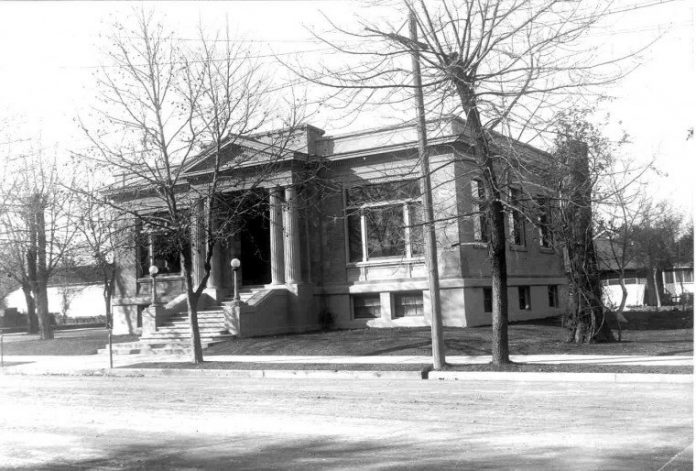Given prominent front page coverage on Nov. 11, 1905, the Gilroy Advocate newspaper exclaimed “Library Site Promised!”
Twice, tax measures failed in 1890 and 1894, but the Gilroy Promotion Society and Ladies’ Auxiliary Society petitioned the Gilroy City Council to establish what the city was lacking – a public library – and the Council agreed. The rest, is history; or at the least undoubtedly historical.
The Council then sought a grant from the Andrew Carnegie Foundation. The “King of Steel” was flexing his philanthropic muscles by giving cities donations to construct Carnegie library buildings. He gave more than $4 million to 1,412 communities in the United States. Gilroy received $10,000 to construct the building on Fifth and Church streets.
Between applying for the grant and construction of the brand–new Carnegie Library in 1909, the Gilroy Public Library and board of trustees were created. Its temporary site was the second floor of Old City Hall.
The project found momentum after a local donated $1,000 to purchase the lot at 195 Fifth St.; William Weeks was brought in from Watsonville as the architect – Gilroy’s library was his seventh Carnegie project – and Mary Briggs Benn was appointed the first librarian in 1907. She earned $30 a month.
On July 27, 1910 the Carnegie Library opened with much fanfare that included an orchestra, choir music, visitors from San Jose’s library and plenty of punch.
“The building is a handsome ornament to the town. It is built of pressed brick and stone, and cost $10,000,” read the story in the Advocate’s July 30, 1910 edition. (The Dispatch traces its history back to The Advocate and before, to 1868.)
The Gilroy Museum was started by Armand White as a Pioneer Display after the basement was finished around 1958; In 1963, it was acknowledged as the Gilroy Historical Museum and became a city-funded operation.
In 1963, the library joined the Santa Clara Valley Library System, and around this time the Library and Culture Commission outlined reasons for the construction of a new building, which existed from 1975 until its demolition to construct the 2012 library in the same location on Rosanna Street.
The library in 1910 was built to serve a population of 1,700, the start of their persuasive essay began, and now the population was nearing 10,000 residents in the 1970s. Today, about 50,000 people live in Gilroy.
“There are only eight chairs in the children’s area,” it continued, “It is impossible to reach the stacks in the main reading room without forcing someone to move. … Lighting is inadequate by modern standards.”
So, in 1966, voters approved a $600,000 bond measure (compare that with $37 million bond voters passed for this library in 2008). The 12,500-square-foot one-story building (with 140 seats throughout) opened to the public Feb. 1, 1975. The building was listed on the National Registry of Historic Places in 1988.
The Historical Museum remains today at the Carnegie Library, and the building itself celebrated its centennial in 2010.
“It was, however, not just the generous gift of Andrew Carnegie that made the Gilroy’s public library a reality, but also the farsightedness and hard work of that first board of trustees, the first librarian and all of the boards of trustees and librarians since them,” according to essays kept by the Gilroy Historical Museum.
Essays from the Gilroy Historical Museum were used in this story.














